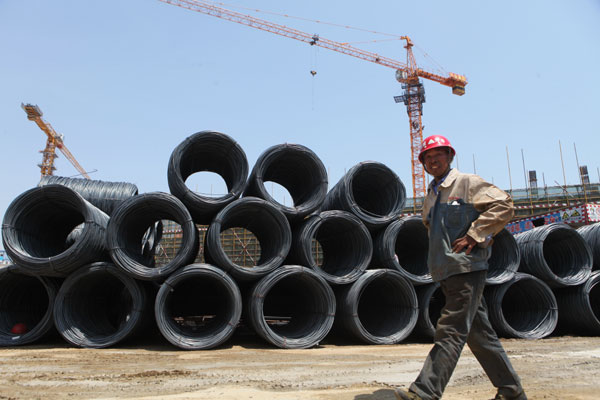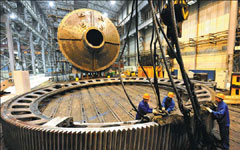|
 |
| A worker walks past steel products in Rizhao, Shandong province. China's preliminary Purchasing Managers Index was 49.7 in May, according to HSBC Holdings Plc and Markit Economics. Provided to China Daily |
BEIJING - Growth in China's manufacturing sector continued to accelerate in May, hitting a five-month high and adding to signs of a stabilizing economy, official data showed on Sunday.
The purchasing managers' index (PMI) increased to 50.8 in May from 50.4 in April, according to data released by the China Federation of Logistics and Purchasing (CFLP) and the National Bureau of Statistics (NBS).
Factory activity pickup
|
|
|
 Feb manufacturing PMI drops |
This is the third consecutive monthly uptick in the widely watched data. The index, seen as one of the key indicators of economic performance, began to climb in March after three months of declines.
Zhang Liqun, a researcher at the Development Research Center (DRC) of the State Council, pointed to the improving data as an indication that "The economy continued to stabilize, and this trend is becoming evident."
Eight of the 12 sub-indices in the PMI registered growth, with the sub-index for production edging up 0.3 to 52.8 after dipping 0.2 in the previous month, according to the NBS and the CFLP.
The sub-index for new orders, seen by analysts as the most important of all sub-indices, jumped by 1.1 to 52.3 in May after gaining 0.6 in April.
The sub-index for export orders, which slumped by 1.1 in April, reversed the declining trend and rose by 0.2 to 49.3.
The employment sub-index of the PMI dipped to 48.2 from April's 48.3, pointing to contraction in the job market.
The data came as a boon to the world's second-largest economy, which had seemed to be losing steam in the past few months.
China's economy grew at its weakest pace in 18 months in the first quarter, expanding by 7.4 percent, lower than the 7.5-percent growth rate target set by the central government earlier this year.
Cai Jin, deputy head of CFLP, said that the continuous rising PMI is a reflection of the positive changes in the Chinese economy.
In an interview with Xinhua, Cai pointed to the remarkable improvement in the sub-index for new orders, reflecting foreign and domestic demand, as an indication of a firm foundation for steady growth.
The official reading is also broadly in line with the HSBC/Markit PMI figure, released in late May, which rebounded sharply to 49.7 in May, hitting a five-month high.
Targeted measures showing effects
After clocking double-digit growth rates on average over the last three decades, the Chinese economy has decelerated in the past couple of years. Apart from the improvements in the PMI, other economic data, including investment, industrial output and consumption, have mostly underwhelmed.
As one of the first leading indicators showing economic momentum, the PMI reading could bode well for the second quarter, when the economy is expected to regain some lost ground.
The upbeat data came as no surprise as the central government has unveiled a string of targeted measures to try to steady growth near its target of 7.5 percent without disrupting plans to restructure the economy or worsening problems of overcapacity and debt.
"Judged from the PMI readings of the recent two months, the growth-bolstering measures are showing effects, and the economy has been improving further," said a research note from the China Logistics Information Center (CLIC).
The think tank expects a series of new growth-boosting measures soon to produce "accumulative effects" for the whole economy in the next few months.
These so-called "targeted" measures include cutting reserve requirement ratios (RRR) for rural banks, speeding up railway and public housing construction, and tax breaks for small businesses.
On Friday, the State Council announced additional policy easing measures, promising to increase "targeted" monetary and credit easing, lower corporate financial burdens and accelerate policy implementation.
More specifically, China will lower the RRR for banks whose lending is geared toward the real economy, especially small businesses and the farming sector, according to a statement issued after a cabinet meeting.
Growth momentum not confirmed
In spite of the upbeat data, experts have cautioned that it is still too early to say that the economic slowdown has completely reversed and economic momentum is confirmed.
While the sub-indices for new orders and export orders both rose in May, the sub-indices for stocking as well as production and business operations both declined, pointing to still cautious attitudes held by companies toward the future market, said Zhang.
"This means there are still no adequate conditions for economic growth to pick up in an evident manner," Zhang added.
Echoing Zhang, Cai of CFLP said, "The Chinese economy still maintains the momentum of steady growth, beating market analysis several months ago."
However, it is not the time for complacency, and the downward pressure on economic growth still deserves attention, Cai added.
While attributing the PMI pickup mainly to the "targeted" economy-boosting measures, Cai said the "endogenous power" for economic growth is yet to be confirmed, and small businesses still hold cautious expectations for future business activities.
In addition, overseas market demand remains weak and full of uncertainties despite increasing domestic demand, which could be reflected in the tiny recovery in the sub-index for export orders, Cai said.
